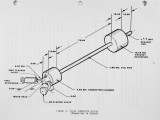| Title |
Basic Research on Pulse Combustion Phenomena With Applied Objectives |
| Creator |
Corliss, John M.; Putnam, Abbott A.; Barnes, Russell H.; Ivancic, William A. |
| Publisher |
Digitized by J. Willard Marriott Library, University of Utah |
| Date |
1985 |
| Spatial Coverage |
presented at Livermore, California |
| Abstract |
This paper describes the procedures and results of a research program conducted at Battelle to investigate the reignition, flow, and mixing phenomena in pulse-combustion systems. This program was conducted under funding from the Basic Research Department at the Gas Research Institute. Mr. James A. Kezerle provided project management and technical review on behalf of GRI. This project involved development of an all-quartz pulse-combustion system for use with nonintrusive optical diagnostic techniques. Three techniques were used including (1) high-speed photography using specially image-intensified techniques, (2) Laser Raman Spectroscopy, and (3) CH and OH optical emission measurements. The objective of this work was to investigte flow, mixing and reignition during the cycle. Optical measurements allow these studies to be undertaken without disturbing the flows. Results indicate that the combustion process is never actually terminated in the pulse-combustion system. Rather, the combustion process occurs in a cyclically repeatable manner, having, at minimum, a low but measurable ,evel of activity. The bulk of the combustion activity occurs T high-intensity bursts at operating frequency ranging from 50 to 65 Hertz for the system studied. The Raman measurements confirmed findings from the high-speed movies. The Raman data consisted of CH4 concentrations. The CH4 concentration in the combustor decreases to immeasurably low values at about the same instant in time as the CH intensity is at a peak. Furthermore, OH intensity closely follows CH intensity and precedes the onset of maximum system temperature. Combustion begins at the lowest pressure portion of the cycle and is essentially completed near the pressure peak. Small cells of combustion activity continue until fresh fuel and air are drawn into the system and the cycle is repeated. For the measurements described in this paper the overall system operated with an equivalence ratio of 1.5 (air to fuel). Even with this level of excess air, CH4 concentration was measured to be a maximum of 16 percent by volume in the cycle. These findings indicate that the fundamental operation of the pulse combustor is controlled primarily by mixing phenomena. |
| Type |
Text |
| Format |
application/pdf |
| Language |
eng |
| Rights |
This material may be protected by copyright. Permission required for use in any form. For further information please contact the American Flame Research Committee. |
| Conversion Specifications |
Original scanned with Canon EOS-1Ds Mark II, 16.7 megapixel digital camera and saved as 400 ppi uncompressed TIFF, 16 bit depth. |
| Scanning Technician |
Cliodhna Davis |
| ARK |
ark:/87278/s6280b4t |
| Setname |
uu_afrc |
| ID |
2328 |
| Reference URL |
https://collections.lib.utah.edu/ark:/87278/s6280b4t |
























